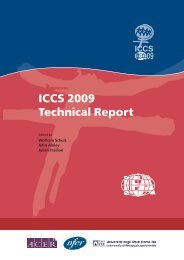Teacher Education and Development Study in Mathematics - IEA
Teacher Education and Development Study in Mathematics - IEA
Teacher Education and Development Study in Mathematics - IEA
You also want an ePaper? Increase the reach of your titles
YUMPU automatically turns print PDFs into web optimized ePapers that Google loves.
158<br />
TEACHER PAY AND STUDENT MATHEMATICS ACHIEVEMENT<br />
Thail<strong>and</strong><br />
Background<br />
In the past few decades, Thail<strong>and</strong> has shifted from an agrarian to a predom<strong>in</strong>antly<br />
<strong>in</strong>dustrial <strong>and</strong> service economy, with about 60% of its labor force currently work<strong>in</strong>g <strong>in</strong><br />
the non-agricultural sector. The country’s relatively strong economic performance has<br />
been accompanied by a rapid <strong>in</strong>crease <strong>in</strong> primary <strong>and</strong> secondary school enrollments. 26<br />
The Thai government stresses the importance of enhanc<strong>in</strong>g educational quality rather<br />
than just quantity, <strong>in</strong> order to produce a more adaptable, <strong>in</strong>novative, <strong>and</strong> competitive<br />
labor force. 27<br />
By 2004/2005, only about 10% of Thail<strong>and</strong>’s adult population possessed a tertiary<br />
or advanced degree; however, another 13% possessed a type B tertiary or uppersecondary-school<br />
degree (UNESCO, 2005). Recent studies show that Thai students<br />
are not perform<strong>in</strong>g satisfactorily <strong>in</strong> the fields of mathematics, sciences, <strong>and</strong> foreign<br />
languages, <strong>and</strong> that the country needs to improve its science <strong>and</strong> technology education<br />
(Office of the <strong>Education</strong> Council, 2004). <strong>Teacher</strong>s are seen as a key component <strong>in</strong><br />
promot<strong>in</strong>g education of a higher quality <strong>in</strong> Thail<strong>and</strong>, especially <strong>in</strong> the areas of science<br />
<strong>and</strong> mathematics.<br />
Composition of the teacher labor force<br />
In 2001, Thail<strong>and</strong> employed 254,435 primary, 39,870 lower-secondary, <strong>and</strong> 85,569<br />
upper-secondary teachers with various skill levels (Office of Commercial Services, 2002).<br />
The number of primary school teachers <strong>in</strong>creased by 0.6% between 2000 <strong>and</strong> 2004, but<br />
the number of secondary school teachers decreased by just under 4% over the same<br />
period (UNESCO, 2005). The teacher–student ratio has also decreased <strong>in</strong> recent years,<br />
stabiliz<strong>in</strong>g at a 1:19 ratio for primary schools <strong>and</strong> a 1:21 ratio for general secondary<br />
schools <strong>in</strong> 2002 <strong>and</strong> 2003 (Office of the <strong>Education</strong> Council, 2004). In 2004, just under<br />
58.5% of primary school teachers <strong>and</strong> 51.5% of secondary school teachers were female,<br />
a percentage somewhat lower than that of most other countries (UNESCO, 2004).<br />
Primary education is characterized by a huge oversupply of teachers, with only one <strong>in</strong><br />
10 prospective teachers be<strong>in</strong>g able to f<strong>in</strong>d a job <strong>in</strong> 2002 (Office of Commercial Services,<br />
2002). A study by the <strong>Teacher</strong> <strong>Education</strong> Reform Office <strong>in</strong> 1998 predicted an excess of<br />
120,000 tra<strong>in</strong>ed teachers by 2002. Another study (Fry, 1999) found that post-secondary<br />
<strong>in</strong>stitutions had tra<strong>in</strong>ed 20 to 25 times more prospective teachers than needed. Despite<br />
this situation, there was a significant shortage <strong>in</strong> qualified science, mathematics, <strong>and</strong><br />
foreign language teachers <strong>in</strong> secondary schools.<br />
Policies s<strong>in</strong>ce the turn of the century have recommended early retirement programs<br />
<strong>in</strong> order to manage the large number of ag<strong>in</strong>g <strong>and</strong> experienced teachers established<br />
<strong>in</strong> traditional rote-learn<strong>in</strong>g methods. A strong, negative relationship between age <strong>and</strong><br />
qualifications supported this recommendation (Fry, 1999). In 1999, the average teacher<br />
was 45 years old, had 22 years of teach<strong>in</strong>g experience, <strong>and</strong> possessed either a diploma<br />
26 By 1998, nearly 91% of the relevant age cohort was enrolled <strong>in</strong> primary schools <strong>and</strong> just over 72% <strong>in</strong> secondary<br />
schools. By 2004, there were 5,539,908 primary school students, 2,732,862 lower-secondary school students, <strong>and</strong><br />
2,126,938 upper-secondary school students (Office of the <strong>Education</strong> Council, 2004).<br />
27 For example, the 1997 Constitution of the K<strong>in</strong>gdom of Thail<strong>and</strong> ratified 12 years of free basic education for<br />
every child, <strong>and</strong> also acknowledged the importance of decentralized education management. The 1999 National<br />
<strong>Education</strong> Act that followed was further amended <strong>in</strong> 2002, <strong>and</strong> it led to a more concrete <strong>and</strong> comprehensive<br />
reform that <strong>in</strong>cluded prospective changes concern<strong>in</strong>g teacher <strong>and</strong> educational personnel.

















